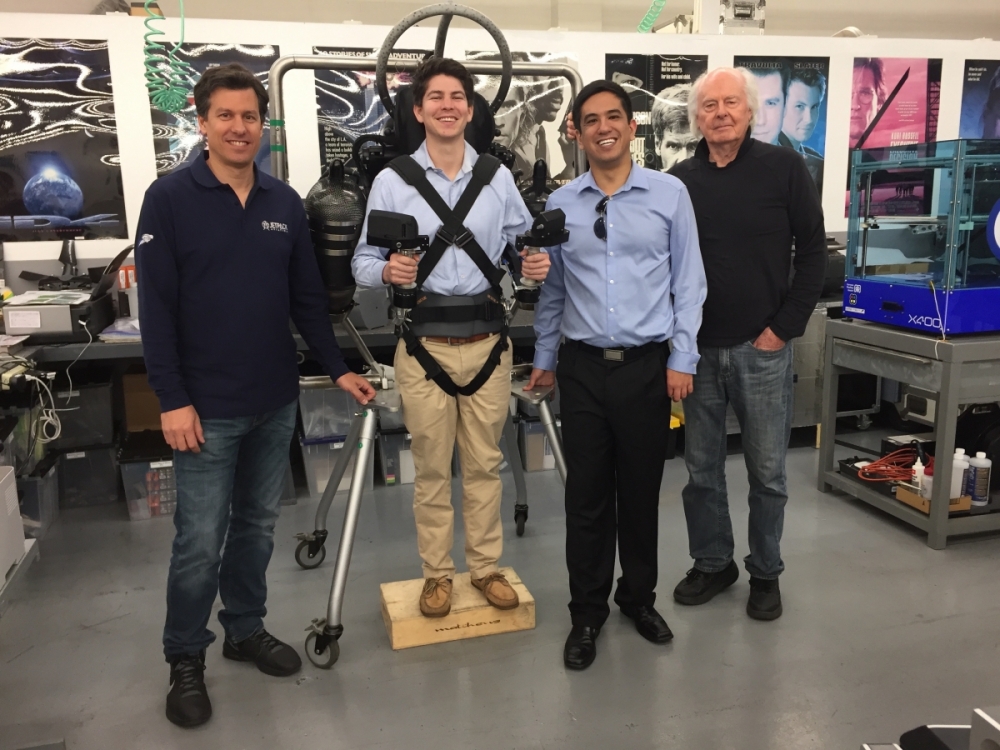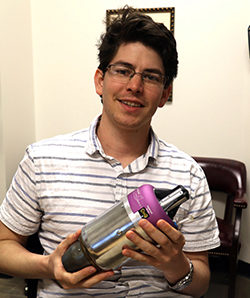 |
| Better than George Jetson. AE researcher Juan-Pablo Afman is seen here wearing the jetpack system that he and fellow Georgia Tech Research Institute researchers will be developing for possible use by the military. Joining him here are, from left, JetPack Aviation's Stefano Paris, GTRI colleague Michael Mayo, and JetPack's Tyler Nelson. Here's a video of the system's maiden flight. |
A team of Georgia Tech researchers is working with a private company to develop a new system that could (eventually) put you in flight.
That is: only you. No carry-on. No peanuts. And no flight attendant to show you the emergency exit.
 |
| AE Prof. J. V. R. Prasad |
The system that could re-introduce a new generation to air travel is the Soldier Vertical Mobility System (SVMS) - a backpack-type propulsion system that allows individuals to hover, travel, and maneuver hundreds of feet above the ground before negotiating a safe, hard-surface landing. Researchers out of the Georgia Tech Research Institute (GTRI) are using a $65K Independent Research & Development (IRAD) grant to collaborate with the JetPack Aviation Corporation on the development of three specific subsystems that will catapult this concept into routine use.
Think: George Jetson or Lost In Space. It’s truly the stuff of comic book fantasy. But Tech researchers take a decidedly more sober perspective.
“For now, it’s really geared toward military applications – to get military personnel into tough terrain or to transport emergency personnel into an emergency situation,” says AE research engineer, Juan-Pablo Afman.
“But last year, JetPack’s owner demonstrated its capabilities by flying around the Statue of Liberty. It’s real. And it really does look cool.”
JetPack Aviation has already secured Cooperative Research and Development Agreement (CRADA) from the U.S. Navy to further develop its proprietary technology. Going forward, the company hopes to attract additional support
 |
| Juan-Pablo Afman with one of the new components that he will be using in the next iteration of the JetPack Aviation SVMS, which will be demonstrated later this year. |
from other funders who recognize the myriad practical applications for the system.
The original version of the system used some commercial off-the-shelf (COTS) components that the Tech engineers are now reviewing as they put together the next iteration of the SVMS. They are also adding new functionality to make the system more attractive to potential investors, like the military. Research engineers Courtland Bivens and Michael Mayo have been leading the collaboration and coordinating the integration of all subsystems into the SVMS.
“One of the things that needs to be worked on is landing. The jetpack itself is heavy – maybe 150 pounds. So if you come in for a landing with too much force, you could damage your legs,” says Mayo. “That’s one of the reasons we're working on an exoskeleton.”
Addressing the landing issues – and other challenges -- is a multi-disciplinary team comprised of engineers from the Daniel Guggenheim School (AE), the George Woodruff School (ME) and GTRI’s Aerospace, Transportation and Advanced Systems (ATAS) and Electronic Systems (ELSYS) labs. Together, the team is working with JetPack Aviation to develop:
- An autonomous control system for the SVMS. Among other things, this will allow the system to auto-stabilize in turbulent conditions, auto-hover while the pilot completes surveillance tasks, and establish safe flying conditions overall;
- A pilot exoskeleton that will support the weight of the jetpack, allow in-flight mobility, and protect vulnerable limbs from taking the brunt of high-impact landings; and
- A Heads-Up Display (HUD) helmet that will allow the pilot to use augmented reality eyewear to constantly monitor key functions of the jetpack’s operation such as altitude, forward and vertical velocity, fuel level, and pilot orientation.
"We are adding a new control system, to automate many of the tasks that could otherwise distract the pilot. This has great potential for soldiers in the field because they need to have their attention on other things -- like where the enemy is and where the next mission should fly," says Mayo.
"In the next iteration, we'll be able to demonstrate how the pilot can just push a button and control where he's going and how fast, without having to concentrate on it. The benefits for that, in wartime, are obvious."
Afman and his mentor, Prof. J. V. R. Prasad who, are working on this system.
"The automation features of the system that we are developing will make it easy and safe to operate with very minimal training," says Prasad.
From the School of Mechanical Engineering, Prof. Jun Ueda’s lab has been developing the exoskeleton. Dr. Jeff Hurley of the ELSYS lab has been developing the HUD helmet.